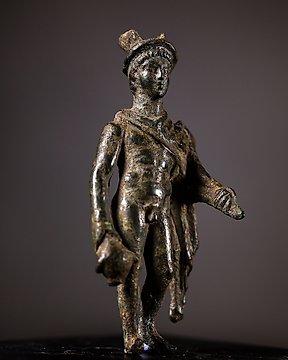
Starożytny Rzym Brązowy Postać BogaMerkurego - 9 cm
Nr 84323875

Nr 84323875

Votive Wolf Figure.
Iberian, 5th - 1st century BC.
Bronze
6.2 cm L.
PROVENANCE: Private collection, Munich, Germany. Acquired from Titiana & Slavey Art Numis, Munich, copy of the bill of sale is attached.
Private collection, Estepona, Malaga.
CONDITION: Good condition, intact.
DESCRIPTION:
Iberian bronze statuette, worked in a rounded bulk, representing the figure of a wolf lying down in a resting position, with its hind legs bent and its front legs stretched out in front of it. The head is large, with the ears erect and alert, large oval eyes and a wrinkled muzzle as it draws back to open its mouth. The open jaws show something inside, which is difficult to distinguish. The realism of the movement, reflecting the artist's direct knowledge of nature, contrasts with the general schematic nature of Iberian art, especially in votive offerings.
Among the Iberians, the wolf had a funerary symbolism, with an apotropaic meaning due to its ferocity. It was also linked to night, war and death, which is why its representation is not uncommon in important pieces such as the chariot top from Cortijo de Maquiz (fig. 1), or in votive objects offered as votive offerings (fig. 2). The production of votive offerings in the form of animals, both domestic and wild (fig. 3), was also common, so this could be the function of this figurine, which would have been deposited in a shrine as a propitiatory offering.
The name Iberian refers to the human groups that inhabited the Mediterranean and southern areas of the Iberian Peninsula between the 4th century BC and the Romanisation of the area, until the 1st century BC. The Iberian culture therefore extended over a wide area stretching from Andalusia to Languedoc in southern France. It was a creative, advanced civilisation, sustained by a society organised around fortified hilltop cities, strongly hierarchical and linked by trade with the Greeks and Phoenicians.
The Iberians developed their own art, with a marked personality and, at the same time, permeable to Eastern influences, especially those of classical and Hellenistic Greece. Indissolubly linked to religion, Iberian art is related to funerary beliefs and the development of sanctuaries, which had a dual function as a sacred place and as a border marker. The interpretation of the works of art found in Iberian necropolises and sanctuaries allows us to learn about the beliefs of this people, their legends and even the personal religiosity of individuals.
Particularly noteworthy are the votive offerings, one of the most characteristic manifestations of Iberian culture, generally made in lost-wax bronze, although they have also been preserved in stone and terracotta. These are small statuettes, around 10 cm in height (the largest are no more than 25 cm), commissioned by high-ranking figures to be offered in the sanctuaries in exchange for protection, well-being, health or prosperity. In fact, most of them have been found in the cave sanctuaries of Despeñaperros, Sierra Morena and Castellar, in Jaén, as well as in La Luz, Murcia. Although they are a very heterogeneous group, they are generally stylised images of men or women in a reverential attitude, with exaggerated features or sexual organs (in the case of those related to fertility), although there are also known votive offerings representing horsemen, horses and other animals and also parts of the body, the latter related to the healing of illnesses or specific limbs.
BIBLIOGRAPHY:
- ARANEGUI GASCÓ, C. Los íberos ayer y hoy. Arqueologías y culturas. Marcial Pons Historia. 2017.
- BERMEJO TRIADO, J. Breve historia de los íberos. Nowtilus. 2010.
- PRADOS TORREIRA, L. Exvotos ibéricos de bronce del Museo Arqueológico Nacional. Ministerio de Cultura. 1992.
- QUESADA SANZ, F. “Los íberos y la cultura ibérica”, en CELESTINO PÉREZ, S., coord., La protohistoria en la Península Ibérica. Akal. 2017.
- RUEDA GALÁN, C.; HERRANZ SÁNCHEZ, A.B.; BELLÓN RUIZ, J.P., coord. Exvotos íberos. Paisajes sagrados, peregrinaciones y ritos. Universidad de Jaén. 2021.
- RUIZ, A.; MOLINOS, M. Los íberos. Análisis arqueológico de un proceso histórico. Grijalbo. 1993.
- TARRADELL, M. Arte ibérico. Polígrafa. 1968.
- VV.AA. Revista de Estudios Ibéricos. Universidad Autónoma de Madrid. 1994-1998.
PARALLELS:
Fig. 1 Chariot finial with a wolf's head. Cortijo de Maquiz, Mengíbar (Jaén), 4th c. BC Bronze. National Archaeological Museum, Madrid, inv. 1970/54/1.
Fig. 2 Vase fragment (votive offering) with a wolf's head. El Amarejo, Bonete (Albacete), 4th-3rd c. BC. Polychrome pottery. Museum of Albacete, inv. CE09868.
Fig. 3 Bear votive offering. Sanctuary of Collado de los Jardines, Santa Elena (Jaén), 4th-1st century BC. Bronze. National Archaeological Museum, Madrid, inv. 29381.
Notes:
- The piece includes authenticity certificate.
- The piece includes Spanish Export License (Passport for European Union) - If the piece is destined outside the European Union a substitution of the export permit should be requested, can take between 1-2 weeks maximum.
- The seller guarantees that he acquired this piece according to all national and international laws related to the ownership of cultural property. Provenance statement seen by Catawiki.
Jak kupować w serwisie Catawiki
1. Odkryj coś wyjątkowego
2. Złóż najwyższą ofertę
3. Dokonaj bezpiecznej płatności